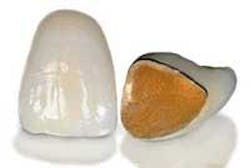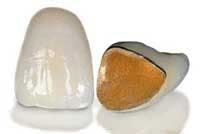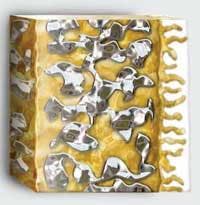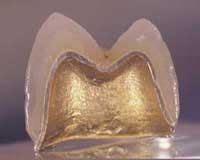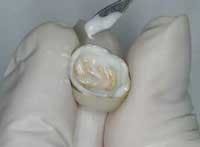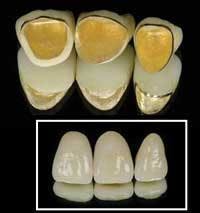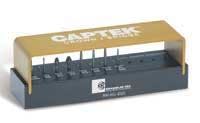Tips from the lab
One of the hottest products in the restorative world is a crown that is now on the market in its 10th year. Captek “composite metal” crown and bridge material (see picture at left) has been and will continue to be a staple restoration for our doctors and thousands of others around the country. In this edition of “Tips from the Lab,” we will touch upon some of the many aspects of Captek and some personal tips on how to maximize the benefits and assure the potential of the system.
What is Captek?
There is a tremendous amount of confusion about the nature of Captek. It is obvious by the bright gold internal surface that gold is involved somehow, but it is the way the gold is involved that makes the difference. Remember, Captek is referred to as a “composite metal” or by some as a “reinforced gold.” If we examine a cross-section of Captek (see picture at right), one can see that the structure is not a pure gold. Internally, within the gold, is a highly organized structure of hard, strong particles of platinum and palladium. These particles (represented in the illustration at right in platinum color) are the filler and the gold is only the matrix, with the combination creating a balance of hardness and resiliency. This unique nature of Captek is the key to the physical and therapeutic properties. Sadly, we come across dentists who think they have had issues with Captek yet, when we investigate the situation, it was a completely different material. Don’t be fooled into thinking what you are getting is in fact Captek. Call the company to validate that you are using a Captek-certified lab and that they have the most up-to-date training.
Why Captek?
Metal-based restorations give the dentist the ability to cement, prepare in multiple margin designs, create collars, adjust occlusion during the try-in stage, do multiple units and splints, completely block out underlying tooth colors, and temporarily cement when necessary. The composite metal is designed to be on average .3 mm thick and is still stable at this thickness (or thinness). .3 mm thick is half the thickness of traditional metal ceramic thickness. Captek certainly provides more room and a better color for the ceramist to build upon. The thinness of the metal and the color certainly add up to dramatically improved esthetics, especially in the critical gingival third.
Below are some clinical benefits of the Captek system and some clinical suggestions on how to maximize those clinical benefits.
Feature: Great Fit Potential
Benefit: More secure feeling during seating, better marginal seal, and better potential for more accurate occlusal and contact relationships. Less chairside adjustments.
David’s advice: Make sure to give normal retention and resistance form to preparations. Build up preparations back to more ideal form when necessary. Preparations with a high degree of taper will not accommodate a solid seating restoration. Maintaining occlusal convergence for posterior teeth will help to achieve secure and accurate fits too. Too often, we see flat occlusal preparation form in the lab. In addition to lessening the potential resistance form, many times we see overreduced buccal and or lingual occlusal edges and underreduced central fossas. This is a common scenario when we see failure. Thin porcelain is weak no matter what the substructure.
The basic Captek lab procedure creates an even layer coping around the preparation. Additional structure can be added. But, if the preparation follows the anatomical contour of the tooth to be restored (cross section of a premolar, see photo at right), not only will the preparation itself lend stability, there is also less technical judgment necessary by the laboratory personnel.
Do not overfill a Captek restoration with cement. A well-fitting restoration like Captek only needs to be lined internally (see photo at left). Also, if ideal preparation tapers do not exist, the Captek crown needs to be air abraded with 50 micron aluminous oxide at around 40 pounds of pressure to enhance cement bond.
Esthetics: Excellent esthetics with any
margin design (see photos at right).
Benefits: The dentist is not confined to preparing a definitive shoulder for every case in order to achieve outstanding esthetic results. This is highly important with implants, metal post, thin teeth, dark teeth, retreated teeth, malaligned teeth, and endodontically treated teeth.
David’s advice: Versatility of margin design is a tremendous benefit with Captek. This could also be an area of confusion. The Captek company, in conjunction with Brasseler, put together a wonderful preparation kit (see photo below) and discussion CD. We have found it to be a useful tool too. We use a few simple rules at the lab to help our dentists achieve the full esthetic potential of Captek specific to margin design.
Captek with a porcelain shoulder margin: If we are not masking out underlying prep color and the tooth is positioned ideally, a definitive chamfer or shoulder placed right at or slightly above the free gingival margin will give outstanding esthetic results.
Captek with metal extended to the edge: Any time we are masking out underlying tooth colors or when the margin is in a subgingival position. Make sure to reduce at least .5 mm at the margin edge to allow for good profiles and to position the margin at least .5 to 1.0 mm within healthy predictable secular depth. This is probably the most common scenario we see with Captek. It works great.
Captek with a metal collar: A collar is mandatory whenever a bevel margin is present. This is especially true when the bevel has more than a 45 degree angle. This will allow for good profiles and less chance of porcelain cracking at the thin edge during the seating process. Collars can still accommodate wonderful esthetic results with Captek. Once again, the collar needs to be placed subgingivally where esthetics are a must. Many more dentists are asking for collars everyday, not only when a bevel exists. With metal to the edge and with Captek collars, the plaque resistance of Captek really becomes evident. We just do not get reports of typical recession around Captek restorations as we see with other materials. This is the reason why dentists who have used Captek for many years are prescribing it as their standard restoration.
On a side note, remember that Captek was a “composite metal.” When we polish a collar and expose the internal metal composite, the color is more of a whitish gold. This has surprised many dentists expecting a high yellow look. This is not a problem if everyone knows what to expect. In fact, it is the composite metal that is proven to have the therapeutic potential for long-term tissue health.
Conclusion: With good lab work and better understanding, Captek is more than special - it is normal.
David French comes from a dental family and as such has been exposed to issues in dentistry for many years and from diverse perspectives. Since 1975, he has been a dental technician. His initial training began as an in-house technician for Dr. Archie French in Arcadia, Calif. He came to Burbank Dental Laboratory in 1996. He may be reached by e-mail at [email protected].
